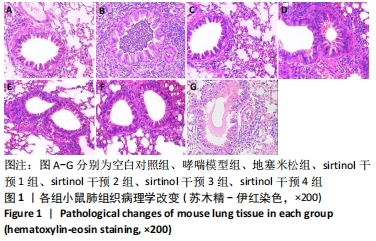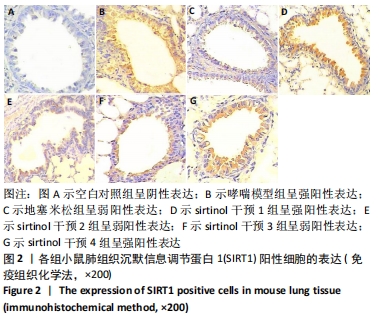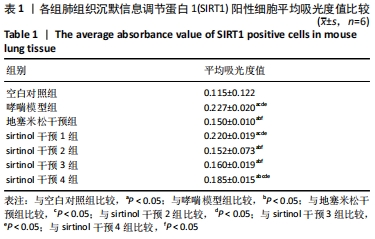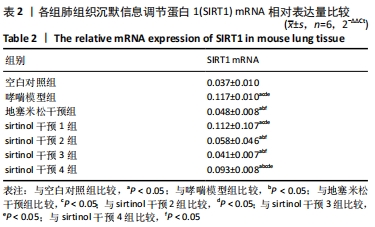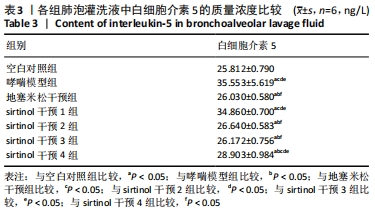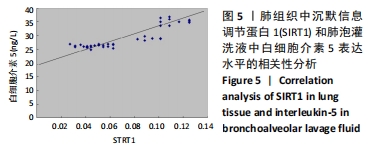[1] 马元,俞琪珺,王正霞,等.黄酮类化合物对支气管哮喘防治作用的研究进展[J].国际呼吸杂志,2019,39(5):373-377.
[2] 麦朗君,饶雪梅,曾学文,等.过敏性哮喘患儿外周血ORMDL3 mRNA与T细胞亚群Th1/Th2失衡的关系[J].疑难病杂志,2020, 19(7):686-690.
[3] 程丽,蒋毅.嗜酸性气道炎症标志物在哮喘管理中的应用[J].临床肺科杂志,2020,25(10):1604-1607.
[4] ZHU C, ZHANG L, LIU Z, et al. Atractylenolide III reduces NLRP3 inflammasome activation and Th1/Th2 imbalances in both in vitro and in vivo models of asthma. Clin Exp Pharmacol Physiol. 2020;47(8):1360-1367.
[5] SUZAKI I, KIMURA Y, TANAKA A, et al. Successful treatment of eosinophilic otitis media associated with severe bronchial asthma with an anti-IL-5 monoclonal antibody,mepolizumab. Auris Nasus Larynx. 2019;46(1):141-146.
[6] KIM SR, LEE KS, PARK SJ, et al. Involvement of sirtuin1 in airway inflammation and hyper responsiveness of allergic airway disease .J Allergy Clin Immunol. 2010;125(2):449.
[7] KUROTANI R, TOMITA T, YANG Q, et al. Role of secretoglobin 3A2 in lung development. Am J Respir Crit Care Med. 2008;178(4):389-398.
[8] HAIGIS MC, GUARENTE LP. Mammalian sirtuins-emerging roles in physiology, aging, and calorie restriction. Genes Dev. 2006;20(21): 2913-2921.
[9] ARCHER SL. Pre-B-cell colony-enhancing factor regulates vascular smooth muscle maturation through a NAD+-dependent mechanism: recognition of a new mechanism for cell diversity and redox regulation of vascular tone and remodeling. Circ Res. 2005;97(1):4-7.
[10] PAPI A, BRIGHTLING C,PEDERSEN SE, et al. Asthma.Lancet. 2018;391 (10122):783-800.
[11] YANCEY SW,KEENE ON,ALBERS FC,et al. Biomarkers for severe eosinophilic asthma.J Allergy Clin Immunol. 2017;140(6):1509-1518.
[12] CHUNG KF. Targeting the interleukin pathway in the treatment of asthma. Lancet. 2015;386(9998):1086-1096.
[13] SHAMJI MH, DURHAM SR. Mechanisms of allergen immunotherapy for inhaled allergens and predictive biomarkers. J Allergy Clin Immunol. 2017;140(6):1485-1498.
[14] CHO SH, STANCIO LA, HOLGATE ST, et al. Increased interleukin- 4,Interleukin-5,and interferon-gamma in airway CD4+and CD8+ T cells in atopic asthma. Am J Respir Crit Care Med. 2005;171:224-230.
[15] CUI ZL, GU W, DING T, et al. Histone modifi cations of Notch1 promoter affect lung CD4+ T cell differentiation in asthmatic rats. Int J Immunopathol Pharmacol. 2013;26(2):371-381.
[16] 宋华华,蔡欣,赖天文,等.组蛋白去乙酰化酶在哮喘发病机制中的研究进展[J].临床肺科杂志,2021,26(2):311-313.
[17] VASSILOPOULOS A, FRITZ KS, PETERSEN DR, et al. The human sirtuin family: evolutionary divergences and ofunctins. Hum Genomics. 2011; 5(5):485-496.
[18] 杨利生,舒志豪,张齐玉,等.组蛋白去乙酰化酶(SIRT1)抑制剂的研究进展[J].广东化工,2019,46(11):107-108.
[19] MICHAN S, SINCLAIR D. Sirtuins in mammals: insights into their biological function. Biochem. 2007;404(1):1-13.
[20] GUARENTE L, FRANKLIN H. Epstein Lecture: Sirtuins, aging, and medicine. N Engl J Med. 2011;364(23):2235-2244.
[21] SINGH V, UBAID S. Role of Silent Information Regulator 1 (SIRT1) in Regulating Oxidative Stress and Inflammation. Inflammation. 2020; 43(5):1589-1598.
[22] RAHMAN I,KINNULA VL,GORBUNOVA, V, et al. SIRT1 as a therapeutic target in inflammaging of the pulmonary disease. Prev Med. 2012;54 Suppl(Suppl):S20-28.
[23] BARNES PJ, BAKER J, DONNELLY LE. Cellular Senescence as a Mechanism and Target in Chronic Lung Diseases. Am J Respir Crit Care Med. 2019;200(5):556-564.
[24] LEGUTKO A, MARICHAL T, FIÉVEZ L, et al. Sirtuin 1 promotes Th2 responses and airway allergy by repressing peroxisome proliferator-activated receptor-γ activity in dendritic cells. J Immunol. 2011;187(9): 4517-4529.
|

